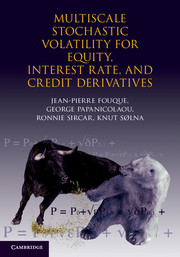Book contents
- Frontmatter
- Contents
- Introduction
- 1 The Black–Scholes Theory of Derivative Pricing
- 2 Introduction to Stochastic Volatility Models
- 3 Volatility Time Scales
- 4 First-Order Perturbation Theory
- 5 Implied Volatility Formulas and Calibration
- 6 Application to Exotic Derivatives
- 7 Application to American Derivatives
- 8 Hedging Strategies
- 9 Extensions
- 10 Around the Heston Model
- 11 Other Applications
- 12 Interest Rate Models
- 13 Credit Risk I: Structural Models with Stochastic Volatility
- 14 Credit Risk II: Multiscale Intensity-Based Models
- 15 Epilogue
- References
- Index
14 - Credit Risk II: Multiscale Intensity-Based Models
Published online by Cambridge University Press: 07 October 2011
- Frontmatter
- Contents
- Introduction
- 1 The Black–Scholes Theory of Derivative Pricing
- 2 Introduction to Stochastic Volatility Models
- 3 Volatility Time Scales
- 4 First-Order Perturbation Theory
- 5 Implied Volatility Formulas and Calibration
- 6 Application to Exotic Derivatives
- 7 Application to American Derivatives
- 8 Hedging Strategies
- 9 Extensions
- 10 Around the Heston Model
- 11 Other Applications
- 12 Interest Rate Models
- 13 Credit Risk I: Structural Models with Stochastic Volatility
- 14 Credit Risk II: Multiscale Intensity-Based Models
- 15 Epilogue
- References
- Index
Summary
As discussed in Section 13.1, the Black–Cox structural model with constant volatility predicts essentially zero-yield spreads at short maturities, because defaults are “predictable” in the sense that we can see them coming. One way to remedy this, as detailed in Chapter 13, was with multiscale stochastic volatility. More traditionally, in the credit risk literature, this observation serves as a motivation for intensity-based (or reduced-form) models in which the default occurs at the jump of an exogenous Poisson-type process. The element of surprise means that, even at short maturities, credit spreads are significant since the default time is no longer announced as in structural models. In addition to the references for background on credit modeling given in the Notes at the end of Chapter 1, we also refer to Bielecki and Rutkowski (2004) for more details on reduced-form models.
The multiname material presented in Section 14.3 is from Fouque et al. (2009) and the material in Section 14.4 with additional grouping structure, is from Papageorgiou and Sircar (2009).
Background on Stochastic Intensity Models
We start with a brief review of the basics of Poisson and Cox processes.
Poisson Process
We begin by recalling the defining properties of a Poisson process (Nt)t≥0 with parameter λ > 0:
(i) It starts at zero: N0 = 0.
(ii) It is a counting process, meaning that it takes successively the values 0,1,2, ….
(iii) It has independent increments.
(iv) […]
- Type
- Chapter
- Information
- Publisher: Cambridge University PressPrint publication year: 2011



